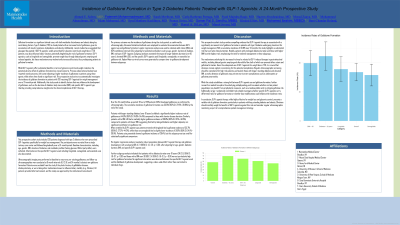Monday Poster Session
Category: Obesity
P3174 - Incidence of Gallstone Formation in Type 2 Diabetes Patients Treated With GLP-1 Agonists: A 24-Month Prospective Study
Monday, October 28, 2024
10:30 AM - 4:00 PM ET
Location: Exhibit Hall E


Ahmed E. Salem, MBBCh
Maimonides Medical Center
Brooklyn, NY
Presenting Author(s)
Ahmed E. Salem, MBBCh1, Hazem Abosheaishaa, MD2, Khaled Elfert, MD3, Syed Mujtaba Baqir, MD1, Morad Zaaya, MD1, Pranay Siriya, MD1, Sarah Meribout, MD1, Syed Matthew. Kodilinye, MD1, Fatemeh Mohammadrezaei, MD1, Mohammed Abusuliman, MD4, Carla Barberan Parraga, MD5, Islam Mohamed, MD6, Samar Pal S. Sandhu, MBBS1, Mohamed Ibrahim, MBBCh7, Daniel A. DiLeo, MD8, Bani Chander Roland, MD8, Manol Jovani, MD1
1Maimonides Medical Center, Brooklyn, NY; 2Icahn School of Medicine at Mount Sinai, Queens, NY; 3West Virginia University, Morgantown, WV; 4Henry Ford Health, Detroit, MI; 5Maimonides Medical Center, New York, NY; 6University of Missouri - Kansas City School of Medicine, Kansas City, MO; 7Cairo University School of Medicine, Cairo, Al Qahirah, Egypt; 8VA New York Harbor Health System, Brooklyn, NY
Introduction: This prospective study aimed to investigate the incidence of gallstone formation in patients with type 2 diabetes undergoing treatment with glucagon-like peptide-1 (GLP-1) agonists for weight loss.
Methods: A cohort of 229 patients with type 2 diabetes prescribed GLP-1 agonists for weight management was followed over 24 months. Baseline data, including demographics, clinical characteristics, and metabolic profiles, were recorded. Regular ultrasonography was performed to detect gallstone development at baseline, 6, 12, 18, and 24 months. Logistic regression analysis was used to evaluate the association between GLP-1 agonist use and gallstone formation, adjusting for age, gender, duration of diabetes, BMI, and GLP-1 agonist type. Subgroup analyses explored the impact of various GLP-1 agonists on gallstone risk.
Results: Throughout the study period, 78 out of 229 patients (34%) developed gallstones. The cumulative incidence rate of gallstone formation was 33.6% (95% CI: 27.6%–39.6%). Significant differences were observed across various subgroups. Patients with a diabetes duration longer than 10 years had an incidence rate of 44.6% (95% CI: 34.8%–54.4%), whereas those with a BMI over 30 had an incidence rate of 39.8% (95% CI: 31.1%–48.5%). Among the GLP-1 agonists, patients treated with liraglutide had a 35.7% incidence rate (95% CI: 27.2%–44.2%), while those on semaglutide had a 31.6% rate (95% CI: 24.1%–39.1%). At univariate logistic regression analysis the association between GLP-1 agonist therapy and gallstone development with an adjusted odds ratio (OR) of 2.1 (95% CI: 1.5–2.9, p < 0.01).Multivariable analysis adjusted for age, gender, duration of diabetes, BMI, and specific GLP-1 agonist preserved the strength of this association (adjusted OR 2.1; 95% CI: 1.5–2.9, p < 0.01), underscoring the heightened risk of gallstones in this patient population.
Discussion: In this prospective we found that there is an increased risk of gallstone formation in patients with type 2 diabetes treated with GLP-1 agonists for weight loss. The findings underscore the necessity for clinicians to recognize this potential complication and implement vigilant monitoring strategies. Tailored patient management plans, including regular ultrasonographic screening and individualized risk assessments, are recommended to mitigate the risk of gallstones in patients undergoing GLP-1 agonist therapy.
Disclosures:
Ahmed E. Salem, MBBCh1, Hazem Abosheaishaa, MD2, Khaled Elfert, MD3, Syed Mujtaba Baqir, MD1, Morad Zaaya, MD1, Pranay Siriya, MD1, Sarah Meribout, MD1, Syed Matthew. Kodilinye, MD1, Fatemeh Mohammadrezaei, MD1, Mohammed Abusuliman, MD4, Carla Barberan Parraga, MD5, Islam Mohamed, MD6, Samar Pal S. Sandhu, MBBS1, Mohamed Ibrahim, MBBCh7, Daniel A. DiLeo, MD8, Bani Chander Roland, MD8, Manol Jovani, MD1. P3174 - Incidence of Gallstone Formation in Type 2 Diabetes Patients Treated With GLP-1 Agonists: A 24-Month Prospective Study, ACG 2024 Annual Scientific Meeting Abstracts. Philadelphia, PA: American College of Gastroenterology.
1Maimonides Medical Center, Brooklyn, NY; 2Icahn School of Medicine at Mount Sinai, Queens, NY; 3West Virginia University, Morgantown, WV; 4Henry Ford Health, Detroit, MI; 5Maimonides Medical Center, New York, NY; 6University of Missouri - Kansas City School of Medicine, Kansas City, MO; 7Cairo University School of Medicine, Cairo, Al Qahirah, Egypt; 8VA New York Harbor Health System, Brooklyn, NY
Introduction: This prospective study aimed to investigate the incidence of gallstone formation in patients with type 2 diabetes undergoing treatment with glucagon-like peptide-1 (GLP-1) agonists for weight loss.
Methods: A cohort of 229 patients with type 2 diabetes prescribed GLP-1 agonists for weight management was followed over 24 months. Baseline data, including demographics, clinical characteristics, and metabolic profiles, were recorded. Regular ultrasonography was performed to detect gallstone development at baseline, 6, 12, 18, and 24 months. Logistic regression analysis was used to evaluate the association between GLP-1 agonist use and gallstone formation, adjusting for age, gender, duration of diabetes, BMI, and GLP-1 agonist type. Subgroup analyses explored the impact of various GLP-1 agonists on gallstone risk.
Results: Throughout the study period, 78 out of 229 patients (34%) developed gallstones. The cumulative incidence rate of gallstone formation was 33.6% (95% CI: 27.6%–39.6%). Significant differences were observed across various subgroups. Patients with a diabetes duration longer than 10 years had an incidence rate of 44.6% (95% CI: 34.8%–54.4%), whereas those with a BMI over 30 had an incidence rate of 39.8% (95% CI: 31.1%–48.5%). Among the GLP-1 agonists, patients treated with liraglutide had a 35.7% incidence rate (95% CI: 27.2%–44.2%), while those on semaglutide had a 31.6% rate (95% CI: 24.1%–39.1%). At univariate logistic regression analysis the association between GLP-1 agonist therapy and gallstone development with an adjusted odds ratio (OR) of 2.1 (95% CI: 1.5–2.9, p < 0.01).Multivariable analysis adjusted for age, gender, duration of diabetes, BMI, and specific GLP-1 agonist preserved the strength of this association (adjusted OR 2.1; 95% CI: 1.5–2.9, p < 0.01), underscoring the heightened risk of gallstones in this patient population.
Discussion: In this prospective we found that there is an increased risk of gallstone formation in patients with type 2 diabetes treated with GLP-1 agonists for weight loss. The findings underscore the necessity for clinicians to recognize this potential complication and implement vigilant monitoring strategies. Tailored patient management plans, including regular ultrasonographic screening and individualized risk assessments, are recommended to mitigate the risk of gallstones in patients undergoing GLP-1 agonist therapy.
Disclosures:
Ahmed Salem indicated no relevant financial relationships.
Hazem Abosheaishaa indicated no relevant financial relationships.
Khaled Elfert indicated no relevant financial relationships.
Syed Mujtaba Baqir indicated no relevant financial relationships.
Morad Zaaya indicated no relevant financial relationships.
Pranay Siriya indicated no relevant financial relationships.
Sarah Meribout indicated no relevant financial relationships.
Syed Kodilinye indicated no relevant financial relationships.
Fatemeh Mohammadrezaei indicated no relevant financial relationships.
Mohammed Abusuliman indicated no relevant financial relationships.
Carla Barberan Parraga indicated no relevant financial relationships.
Islam Mohamed indicated no relevant financial relationships.
Samar Pal Sandhu indicated no relevant financial relationships.
Mohamed Ibrahim indicated no relevant financial relationships.
Daniel DiLeo indicated no relevant financial relationships.
Bani Chander Roland indicated no relevant financial relationships.
Manol Jovani indicated no relevant financial relationships.
Ahmed E. Salem, MBBCh1, Hazem Abosheaishaa, MD2, Khaled Elfert, MD3, Syed Mujtaba Baqir, MD1, Morad Zaaya, MD1, Pranay Siriya, MD1, Sarah Meribout, MD1, Syed Matthew. Kodilinye, MD1, Fatemeh Mohammadrezaei, MD1, Mohammed Abusuliman, MD4, Carla Barberan Parraga, MD5, Islam Mohamed, MD6, Samar Pal S. Sandhu, MBBS1, Mohamed Ibrahim, MBBCh7, Daniel A. DiLeo, MD8, Bani Chander Roland, MD8, Manol Jovani, MD1. P3174 - Incidence of Gallstone Formation in Type 2 Diabetes Patients Treated With GLP-1 Agonists: A 24-Month Prospective Study, ACG 2024 Annual Scientific Meeting Abstracts. Philadelphia, PA: American College of Gastroenterology.

